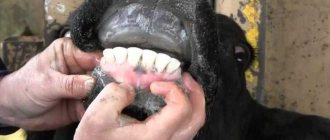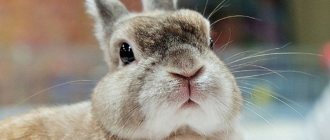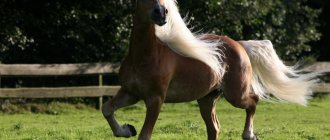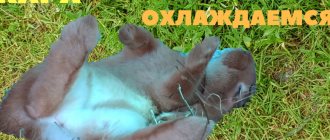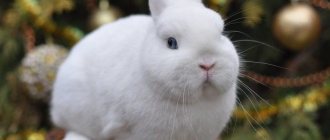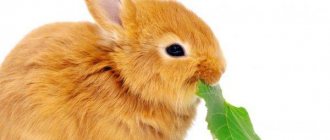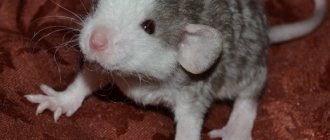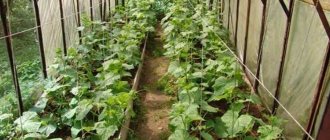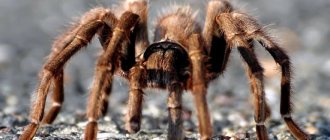At one time, rabbits were classified as Rodents. Clarity was brought to the classification by the American biologist W. Gidley, who identified a separate order for eared animals - Lagomorphs. This decision was made after an in-depth study of the structural features of rodents and rabbits.
The only thing they have in common, as it turns out, is the continuous growth of teeth throughout life, and even then not in all rodents. Otherwise, the rabbit's dental apparatus is different, since it is adapted for capturing plant food and chewing it.
| Differences in teeth | |
| Rabbits | Rodents |
| Two pairs of incisors on the upper jaw | One pair of incisors on the upper jaw |
| An adult has 28 pieces | Total 18 pieces |
| Continuous growth | Only the incisors grow (with the exception of chinchillas and guinea pigs) |
| The incisors move laterally like scissors, helping to “cut” food | Chew captured food with front incisors or lateral molars |
Rabbit teeth, despite their uniqueness and specific natural adaptation, are exposed to many factors that can negatively affect their condition. To exclude possible pathologies, every rabbit breeder should be familiar with their structure, and, if necessary, could help the long-eared pet cope with the problem that has arisen.
Appearance of teeth
Milk teeth are one of the first things that a future rabbit develops in the womb. The process begins already from the third week of development. Babies are born without hair and the ability to see and hear, but with sixteen milk teeth - six incisors and ten chewing teeth.
Starting from the second week of a baby rabbit’s life, its mouth undergoes changes: the milk teeth with which it was born begin to be gradually replaced by permanent ones. The replacement process does not take much time, and the baby, who was born only a month ago, already has 28 full-fledged permanent teeth.
However, the development of the teeth of decorative rabbits is not complete: every week they become longer by 2-3 millimeters.
Wrong diet
If you give tame rodents only vegetables and fruits, this can lead to kidney failure, liver disease, the appendix can become inflamed, and appetite worsens.
It is not for nothing that experts consider hay and dried grass to be the main product on the rabbit menu. Vegetable and fruit supplements cannot be considered complete food; they are an addition to the main diet, as they are rich in fiber, various vitamins and microelements.
Advice: Proper feeding of pets is the main preventive measure against various diseases. If the rodent's body receives the required amount of nutrients, its work will be smooth and the immune system will be strengthened.
The structure and location of rabbit teeth
The decorative rabbit has only two types of teeth:
- Incisors. There are only six of them, and they are not located symmetrically - there are four incisors on the upper jaw, and only two on the lower jaw. In addition, this type of teeth differs in size. The upper incisors are divided into large ones (identical in appearance and size to the lower ones), which can be easily seen behind the lips, and small ones - two tiny, almost indistinguishable teeth located directly behind the large ones. Large incisors have fairly long curved roots, while small ones have a much straighter and smaller root. The rabbit needs incisors to bite off pieces of food (usually grass or hay) of the length it needs to chew.
- Chewing teeth. They are divided into premolars (false molars) and molars. Their difference lies only in the anatomical structure - the appearance, structure and purpose of these teeth are almost identical. Their combination forms one group with common functions. The roots of the chewing teeth are quite long and extend into the bones of the jaw and skull. More than two dozen molars are used by the decorative rabbit for the purpose of chewing food. These teeth turn food into pulp, and the chewing mechanism itself is comparable to a millstone.
Contrary to popular belief, the process of grinding down molars and premolars is not facilitated by the hardness of food, but by the direct process of chewing.
On the upper and lower jaws, the teeth of a decorative rabbit are located symmetrically, but their number differs - 16 teeth grow at the top, and 12 at the bottom. This difference is explained by the absence of small incisors on the lower jaw and a smaller number of premolars.
On each side of the upper jaw there is one large and small incisor, followed by a diastema - a toothless space formed due to the lack of fangs in rabbits. After it there are three premolars and molars. The lower jaw is characterized by the following arrangement and number of teeth: 1 large incisor, 2 false molars and 3 molars.
Both the incisors and molars of rabbits, unlike rodents, grow throughout their lives - they grow up to 1 centimeter per month. The enamel is also different - it is strong and stable on the outside, but on the inside it is soft and pliable, which facilitates the natural grinding process.
Sense organs
Various stimulations, from outside or inside the rabbit, are perceived by the senses, and then the information received is analyzed by the animal’s brain. Eared animals have six types of senses: smell, taste, touch, vision, hearing and balance.
| Olfaction is the ability to perceive smell. It is carried out by receptors that are located in the epithelium of the nose. The rabbit's sense of smell and taste are the most developed senses. | Sound is the vocal transmission of the perception of the world using the larynx, tongue, and teeth. This ability is not typical for rabbits. They can only in some cases (pain, irritation, severe cold or hunger) make sounds similar to hissing, grumbling or squeaking. | Taste is the ability to determine the quality of everything that enters the mouth. Taste sensations are transmitted to eared animals through the papillae of the tongue and oral mucosa. Rabbits distinguish between sour, sweet, and salty, but they hardly feel bitterness. |
| Touch is the perception of external influence (touch, pressure, stretching, cold, heat, orientation). They provide the function of skin receptors, receptors of the musculoskeletal system, and mucous membranes. The most sensitive areas in rabbits are the eyelids, lips, back and forehead. | Vision is the ability to distinguish the external environment using the eyes. Peculiarities of vision in rabbits: • Color perception of the world; • Farsightedness; • Ability to see in the dark. | |
| Hearing is the ability to detect and distinguish sound vibrations from the external environment. Rabbits have large funnel-shaped ears, thanks to which they have very sensitive hearing with a wide sound range. | One of the features of long-eared animals is “vibrissae” (sparse hard bristles-antennae) located on the head. They perform the function of additional organs of touch. Cutting them is strictly prohibited. | Equilibrium is the ability to move in space under the influence of changes in gravitational forces. It is carried out using the vestibular apparatus (in the inner ear). |
Bite
The dentofacial system of decorative rabbits has a specific anatomical structure. It is characterized by protruding upper large incisors, covering the smaller, underdeveloped pair in such a way that detecting it becomes a problem for a pet owner without special education. And it is this “dominant” pair of incisors that plays the main role in the formation of the correct bite.
See also Treatment of diarrhea in rabbits at home
However, for one reason or another, the formation process does not always go smoothly, and deviations may occur that are clearly visible even to a novice rabbit breeder. In this regard, veterinarians distinguish three types of bite in decorative rabbits:
- Normal. When examining a rabbit's teeth from the side, you can see that the upper teeth seem to cover the lower ones. When viewed from the front, the lower teeth follow exclusively the upper teeth. This situation indicates that the bite has formed correctly and does not require any measures.
- Straight. In this case, the teeth of the upper jaw stand above the teeth of the lower jaw, thereby forming a kind of “wall”. This state of affairs is a reason to consult a veterinarian for advice.
- Wrong. This type of bite is accompanied by the opposite of the natural structure of the dental system. The rabbit's lower teeth are located in front, not the upper ones. In general, the appearance resembles the mouth of a bulldog.
The last two types of bite can cause a lot of trouble not only for the owner of the animal, but also for the long-eared pet itself. Therefore, the correct bite must be carefully monitored.
Problems with the gastrointestinal tract
When rabbits are given food of poor quality, stale, or their diet is suddenly changed, this provokes malfunctions of the digestive system. The same thing happens when sanitary standards are not followed.
It may happen that the rabbit swallowed wool or a foreign object with food, or if there are helminths in its body, the stomach and intestines suffer.
Diseases associated with the gastrointestinal tract are expressed in the rabbit's belly bloating, he is tormented by constipation or diarrhea, and the pet refuses to eat. His condition is depressed, his teeth can make a loud grinding sound, and he is in pain.
To prevent possible stomach and intestinal diseases of rabbits, you need to keep the premises with the animals clean, each cage should be cleaned as it gets dirty. Be sure to pay attention to the quality of the feed. Each new product is given little by little; increasing portions should be gradual. Prevention and treatment of helminths is carried out using special anthelmintic drugs.
Dental diseases in decorative rabbits
The oral cavity of rabbits needs increased attention, because teeth are the Achilles heel of these animals. Due to certain factors, dental diseases may develop that are in dire need of help not only from the owner, but also from a specialist.
Malocclusion
Description. Violation of the correct contact between the teeth of the lower and upper jaw, leading to the cessation of the process of natural grinding. Overgrown teeth constantly injure the tongue, cheeks and gums of the rabbit, which causes a lot of pain and discomfort.
- Incorrectly selected diet. In the wild, rabbits take at least 5 minutes to eat. A portion of fresh grass is eaten by the animal within 7 minutes, while hay may take up to 15 minutes. Dry mixed food, which modern long-eared owners are partial to, is chewed by the rabbit in just a couple of minutes. In addition, overly nutritious, high-calorie food quickly satisfies the feeling of hunger. As a result, the 5 minutes of continuous chewing necessary for dental health turns into 1-2 minutes. And ready-made food practically does not contain silicon salts, which are natural abrasives.
Everyone knows that calcium is a building material for teeth. However, for some reason, many rabbit breeders ignore this mineral when preparing the daily menu for their long-eared pet.
- Malocclusion. Some breeds of decorative rabbits are predisposed to malocclusion, for example, their lop-eared representatives.
- Injuries. Impaired closure of the jaws is often the result of trauma to the dental system suffered by the animal and improper healing of the fracture.
- Infections. Bacterial infections affecting the roots of teeth can change the direction of their growth.
Manifestations:
- Decreased appetite. In some cases, the appetite remains, but immediately after the start of the meal the animal stops eating. As a result, your pet may lose weight.
- Violation of personal hygiene. The rabbit stops combing and cleaning itself.
- Uneaten caecotrophs. Stopping the rabbit from eating feces indicates problems with the incisors.
- Refusal of solid and hard food. The rabbit prefers soft food.
- Grooves on teeth. Calcium metabolism disorders lead to thinning of the enamel coating.
- Darkening of teeth. The color of the root part of heavily overgrown teeth changes from pale gray to dark.
- Problems with swallowing. Disturbances in the process of swallowing and chewing food are characteristic of malocclusion. Sometimes rabbits start chewing just like that, without food.
- Intestinal dysfunction. Accompanied by the absence of bowel movements.
- Tearing. With this disease, inflammation in the sinuses may develop.
- Salivation. Characteristic of malocclusion of molars, drooling occurs due to emerging problems with closing the mouth and inflammation of the mucous membrane. The chin is often wet, and the skin in areas where saliva is abundant is inflamed.
- Grinding teeth. This unpleasant sound indicates discomfort and pain felt by the animal.
- Injuries in the oral cavity. Too long teeth injure the mucous membranes, which leads to the development of bleeding and inflammation.
- Suppuration. Strong development of inflammation is fraught with the appearance of edema and abscesses.
See also How to treat rabbit hemorrhagic disease?
Treatment. This disease has no cure. The only thing you can do is go to a veterinary clinic. Here, if necessary, a specialist can trim the teeth to normal size.
You cannot grind rabbits' teeth at home. The procedure must be carried out by a specialist using special tools. Independent “treatment” of malocclusion will lead to complete tooth destruction.
What is malocclusion and how it is treated in veterinary clinics is shown in the video presented:
Root overgrowth
Description. Violation of mineral metabolism leads to weakening of bone tissue and enlargement of the root sector of the teeth. The overgrown roots of the lower jaw are fraught with a relatively safe protrusion of the tubercles, and the course of processes in the upper jaw leads to:
- epiphora - constant lacrimation;
- dacryocystitis - the development of an inflammatory process in the lacrimal sac.
Causes:
- Lack of minerals in the diet. A low calcium content in an animal’s diet and an imbalance of fluoride and calcium often leads to the development of pathology. As a rule, this picture is observed in rabbits, whose diet is not balanced and consists mainly of corn flakes, wheat and peas.
- Impaired absorption of calcium. Intestinal inflammation, infectious diseases, as well as damage to the decorative rabbit by parasites (coccidiosis, worms, etc.) lead to problems with calcium absorption. Sometimes the cause of difficulties is impaired metabolism and age-related changes.
Manifestations:
- Tubercles. The formation of tubercles on the lower jaw in the area of the root part of the molars is the most striking distinctive sign of the disease.
- Tearing. A constant flow of animal tears that does not go away on its own.
- Conjunctivitis and keratitis. They can occur when the roots of the upper jaw grow.
- Malocclusion. Both incisors, molars and premolars.
Treatment:
- Normalization of diet. The owner of the animal must learn how to properly and what to feed a decorative rabbit. It is worth remembering that pets with overgrown roots need roughage with a high calcium content.
- Anti-inflammatory drugs - Traumatin, Traumeel, Engystol and Echinacea Compositum.
- Antibiotic therapy for the appearance of purulent processes. The eyes are washed with Furacilin solution, and eye ointments with antibiotics are used, for example, Tetracycline.
- Metabolism stimulants – Gamavit, Katozal, Cyanofor.
- Preparations for normalizing intestinal function - Liarsin, Veracol, Nux Vomica-Homaccord.
Abscesses and suppurations
Description. Suppuration is a rather serious problem in itself, fraught with a lot of discomfort and difficult to treat. However, an abscess brings much more trouble - a purulent inflammation of tissues characterized by the formation of cavities and bacterial damage. Abscesses not only cause momentary discomfort in the form of pain in the animal and the development of intoxication, but without treatment they inevitably lead to blood poisoning and death.
Causes:
- Mechanical damage. Pathology can occur as a result of injuries during cutting teeth, absorption of sharp objects, bites, scratches, damage to the tongue, cheeks and gums from the sharp edges of overgrown teeth.
- Metabolic disorders and age-related changes. Failures in mineral metabolism, weakened immunity, loss of tooth enamel, proliferation of tooth roots and the development of caries, left unattended, often lead to abscesses.
Manifestations:
- Swelling. Occurs in cases of shallow abscess location.
- Pain.
- Salivation.
- Deterioration of appetite up to complete refusal of food.
- Increase in temperature in the area of suppuration formation.
- In advanced cases, there is an increase in the rabbit’s overall body temperature.
Treatment:
- Operation. Surgery is necessary to open the abscess. Depending on the degree of development of the pathology and depth, both general anesthesia and local anesthesia (blockade using novocaine) can be used.
- Disinfection. That is, installation of drainage, rinsing with solutions (Furacilin) and administration of drugs such as Levomekol and Levosin.
- A course of antibiotics – Enrofloxacin, Baytril.
- Stimulation of metabolic processes. It is carried out with the aim of accelerating regeneration, removing intoxication, and improving general health. Drugs such as Gamavit and Catozal are prescribed.
- Suppression of inflammation. Anti-inflammatory drugs are used - Travmatin, Traumeel and others.
- Treatment. It consists of daily rinsing and applying ointments.
The drainage is removed only after complete cleansing of the opened abscess, and treatment stops no earlier than the cavity is completely closed.
Tooth breakage
Many owners of decorative rabbits can be scared when their pet breaks a tooth. However, in reality there is nothing wrong with this - within two weeks the organ will grow back. But the animal needs some help:
- First of all, you need to check whether the jaw is broken and whether the rabbit is conscious.
- If the answer is yes, then remove the broken piece. If the affected tooth is loose, but cannot be removed without effort, then it is better to try to repeat the removal procedure after half a day. Due to constant growth, the growing new tooth will push the broken fragment, and it will be possible to extract it painlessly for the animal.
- If a tooth breaks due to an impact, inspect the oral cavity for wounds and scratches. If any, then treat with a non-aggressive and painless antiseptic, for example, Chlorhexidine.
- Monitor the condition and activity of your eared pet. If you notice lethargy and lack of appetite, you should immediately seek help from a veterinary clinic.
See also: What to do if a rabbit has snot and how to treat it?
Eye prolapse due to malocclusion.
Prolapse is caused by malocclusion.
In some advanced cases, the roots of the upper teeth, of all types, exert such strong pressure on the eye that it bulges and comes out of its orbit. If the problem is not corrected in time, then there is only one way out - amputation of the eye. Another outcome of the impact on the eyeball is prolapse of the lacrimal gland (prolapse). Of course, animals may have a genetic predisposition to such an anomaly, but if you purposefully and constantly apply pressure to a certain part of the eye, sooner or later the so-called “third eyelid” will appear.
GLAND PROLAPSE of the third eyelid is a prolapse of lacrimal gland tissue from the inner corner of the eye between the third eyelid and the cornea of the eye, it can be one or two-sided. Prolapse of the third eyelid gland is provoked by sudden head movements, jumping, injuries, and inflammatory processes in the eye area and eyelids.
As a rule, the vast majority of rabbits have the correct alignment of their teeth and do not suffer from malocclusion. To gain valuable experience, you can practice a little, watch a few of your pets and remember what the correct bite looks like. Once you detect a single anomaly, you can quickly eliminate it. But if you do not take into account the risk factor and mate a rabbit with malocclusion, it will gradually be transmitted to the entire herd.
I hope that this article will be useful to you, you will be able to protect your rabbits from the above-mentioned scourge and will not allow your pets to suffer excessively from malocclusion and excessive tooth growth. Your admin.
Please share this article with your friends on social networks:
Please rate the article. Ask a question, discuss on the forum.
Teeth chattering and grinding
First of all, teeth grinding in rabbits is a behavioral reaction and does not mean at all that the animal’s teeth need urgent treatment. In the same way, clattering paws does not at all indicate that the pet has problems with its limbs.
Depending on the intensity and volume, a rabbit can express various emotions by grinding, for example:
- slight creaking or chattering of teeth indicates that the animal feels relaxed and satisfied;
- Loud, loud knocking and squeaking noises may be signs of discomfort and pain.
In order to correctly interpret the signals given, the rabbit owner needs to carefully monitor his pet from the first days of its appearance. In this way, body language is gradually learned. Observation and communication will help to quickly recognize signs of dental disease and poor health of the animal in a timely manner. And the sooner treatment is started, the faster the rabbit will recover.
In some cases, teeth grinding in both adult animals and baby rabbits is a sign that not everything is in order with their health. You may also notice that the animal is chattering its teeth. It may not just be the rabbit's incisors. Sometimes long-eared pets by grinding their teeth signal that something hurts inside them.
Possible reasons
While caressing the furry animal, you can hear it quietly grinding its teeth. This sound is unobtrusive and short-lived, it resembles the purring of a kitten. In this case there is no cause for concern. However, the owner of the animal should be alert to the incessant grinding of teeth or their loud knocking. If the rabbit is not eating well, you need to figure out what is bothering the animal. Perhaps he got sick. Let's look at some causes of teeth grinding and lack of appetite in rabbits:
- Stress.
- Discomfort in the mouth.
- Digestive problems.
- Infectious diseases.
Stressful situations
Rabbits are very gentle creatures. Having experienced stress, they can become seriously depressed. Various situations can cause an unstable emotional state in them - a car ride, noise, the arrival of guests, meeting another animal, moving. Pet owners notice that rabbits begin to grind their teeth if they are scared or uncomfortable. This often happens after purchasing a pet, when it is brought to a new home. An unusual environment causes stress in eared animals. After a short adaptation, the animals stop being nervous and their appetite improves.
Caring for the teeth of a decorative rabbit
Caring for the dental system of decorative rabbits involves following a few simple rules:
- Feed your pet correctly. To do this, the diet must be balanced, contain enough minerals and both roughage and succulent and soft food.
- Prevent the animal from getting any injuries. To do this, avoid crowding of rabbits, contact with aggressive pets, avoid sharp objects in the cage, and so on.
- Regular, at least 6 times a year, visits to the veterinarian.
- Pamper animals with toys made of wood. The assortment in pet stores today is extensive, and you can find wooden toys for lagomorphs in a variety of shapes and sizes.
- Regularly give the rabbit branches of trees such as pear, apple, rowan, linden, and willow. These are the most delicious twigs, and all decorative rabbits love them. In winter, you can offer branches of coniferous trees. But before giving, be sure to make sure that the plants have not been treated with chemicals.
- Occasionally pamper your pet with a small piece of white bread as a treat.
- If you have a straight bite, check the condition of your teeth several times a week. Because a straight bite very easily turns into an incorrect bite.
Keeping your pet's teeth healthy is not difficult or expensive, but the same cannot be said about correcting mistakes in the care and maintenance of a decorative rabbit. A little attention and care on the part of the owner of an eared pet - and the animal will delight its owner with a healthy smile for many years.
Prevention
Disease prevention is the best approach when breeding rabbits. As you know, long-eared animals are very sensitive to any diseases, and even a minor disturbance in their body can become a huge danger for them. Such seemingly harmless dental diseases can even end in death. To prevent this from happening, it is important to follow simple recommendations:
- Monitor the animals' diet (should contain hay, branches, coarse grasses).
- Make sure that animals receive enough calcium in their diet (mineral supplements can be given).
- Conduct a periodic examination of the rabbit's mouth and teeth by a veterinarian (recommended for decorative breeds every quarter, and for other species - every six months).
- Avoid breeding and cull rabbits with pathological bites at an early age.
- Make sure that the long-eared animals do not get injured or fight.
- Additionally, if necessary, grind down or remove teeth.
Video Malocclusion or malocclusion in a rabbit
The rabbit stopped eating
Sometimes after giving birth, it is difficult to feed a female rabbit, which negatively affects the production of milk for newborns from the litter. This phenomenon occurs during postpartum stress or infections.
The maternal role is not always perceived quickly by the female; sometimes this will require time for her to adapt. If an individual is in a lying position for a long time, its teeth may grind a little, it may hardly eat, it is better not to touch it, giving it time to come to its senses and calm down.
Symptoms of the disease are considered if: the animal has upset intestines, the eyes are watery, and fluid is released from the nose. The female may also shake her head. In this case, the mother is separated from the rabbits.
Advice: After the rabbit has given birth, her immune system is weak and needs to be strengthened. In case of illness, a veterinarian will help.
In order for the female to feel good after giving birth, she needs help to build a cozy nest, feed her heavily, but not excessively, so that obesity and other digestive problems do not occur.
